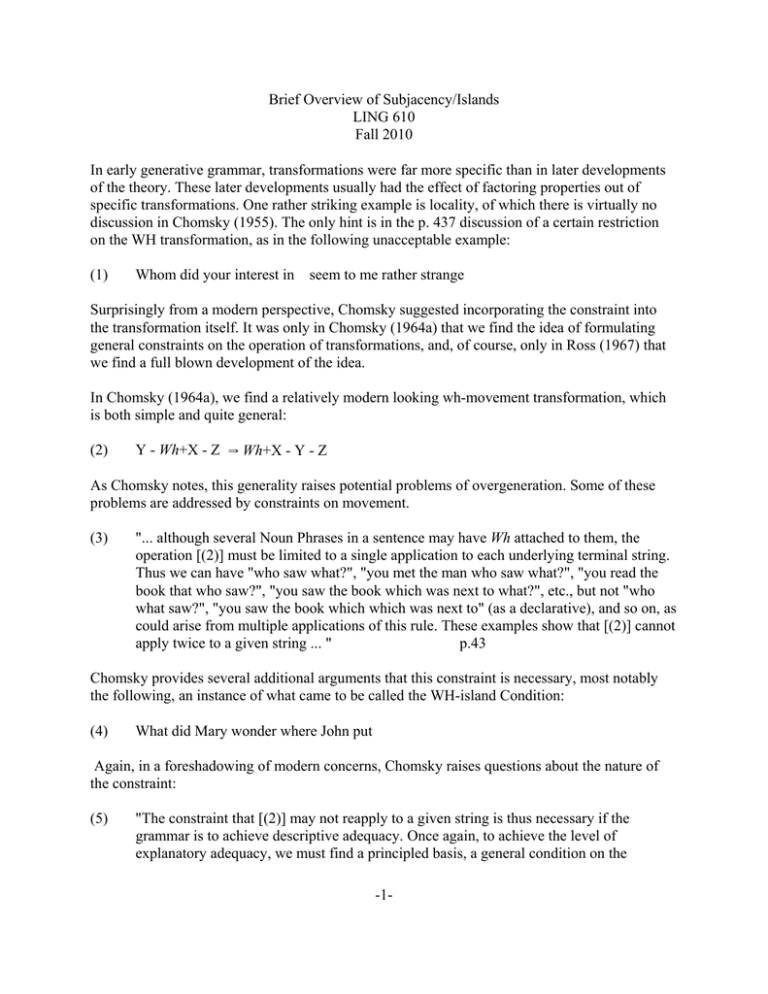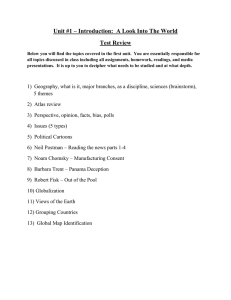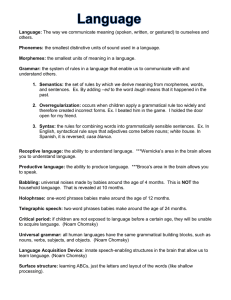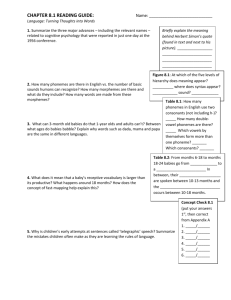Brief Overview of Subjacency/Islands
advertisement

Brief Overview of Subjacency/Islands LING 610 Fall 2010 In early generative grammar, transformations were far more specific than in later developments of the theory. These later developments usually had the effect of factoring properties out of specific transformations. One rather striking example is locality, of which there is virtually no discussion in Chomsky (1955). The only hint is in the p. 437 discussion of a certain restriction on the WH transformation, as in the following unacceptable example: (1) Whom did your interest in seem to me rather strange Surprisingly from a modern perspective, Chomsky suggested incorporating the constraint into the transformation itself. It was only in Chomsky (1964a) that we find the idea of formulating general constraints on the operation of transformations, and, of course, only in Ross (1967) that we find a full blown development of the idea. In Chomsky (1964a), we find a relatively modern looking wh-movement transformation, which is both simple and quite general: (2) Y - Wh+X - Z Y Wh+X - Y - Z As Chomsky notes, this generality raises potential problems of overgeneration. Some of these problems are addressed by constraints on movement. (3) "... although several Noun Phrases in a sentence may have Wh attached to them, the operation [(2)] must be limited to a single application to each underlying terminal string. Thus we can have "who saw what?", "you met the man who saw what?", "you read the book that who saw?", "you saw the book which was next to what?", etc., but not "who what saw?", "you saw the book which which was next to" (as a declarative), and so on, as could arise from multiple applications of this rule. These examples show that [(2)] cannot apply twice to a given string ... " p.43 Chomsky provides several additional arguments that this constraint is necessary, most notably the following, an instance of what came to be called the WH-island Condition: (4) What did Mary wonder where John put Again, in a foreshadowing of modern concerns, Chomsky raises questions about the nature of the constraint: (5) "The constraint that [(2)] may not reapply to a given string is thus necessary if the grammar is to achieve descriptive adequacy. Once again, to achieve the level of explanatory adequacy, we must find a principled basis, a general condition on the -1- structure of any grammar, that will require that in the case of English the rule [(2)] must be so constrained. Various suggestions come to mind, but I am unable to formulate a general condition that seems to me entirely satisfying." p.45 In later developments, Subjacency, Superiority, and Relativized Minimality were proposed as more general constraints from which these specific cases follow. The A-over-A constraint (but not by that name) is also first suggested in Chomsky (1964b), along with the proviso that the constraint is too strong (as discussed in great detail later by Ross (1967)). (6) a What would it be difficult for me to understand b *What would for me to understand be difficult (7) "... in the illegitimate case the Noun Phrase to be preposed is contained within a Noun Phrase [This assumes that subjects are always NPs.], while in the legitimate case, it is not. However, the condition that a Noun Phrase contained within a Noun Phrase is not subject to[(2)], though quite plausible and suggested by many examples, is apparently somewhat too strong, as we can see from such, to be sure, rather marginal examples as 'who would you approve of my seeing?', 'what are you uncertain about giving to John?', 'what would you be surprised by his reading?', etc." p.46 Ross (1967) argued against both of the constraints Chomsky suggested, proposing, in their place, a set of 'island' constraints on movement (or, more specifically, on the 'chopping' part of movement, as Ross decomposed movement into copying and chopping). Some of Ross's constraints: Complex NP Constraint (modified version of a constraint attributed to Ed Klima) (8) No element contained in a sentence dominated by a noun phrase with a lexical head noun may be moved out of that noun phrase by a transformation. (9) a *The man who I read a statement which was about is sick. b The man who I read a statement about is sick. Coordinate Structure Constraint (10) ln a coordinate structure, no conjunct may be moved, nor may any element contained in a conjunct be moved out of that conjunct. (11) a *What sofa will he put the chair between some table and? b *Whose tax did the nurse polish her trombone and the plumber compute? Left Branch Condition (12) No NP which is the leftmost constituent of a larger NP can be reordered out of this NP by a transformational rule. (13) a The boy whose guardian's employer we elected president ratted on us. -2- b *The boy whose guardian's we elected employer president ratted on us. c *The boy whose we elected guardian's employer president ratted on us. Sentential Subject Constraint (14) No element dominated by an S may be moved out of that S if that node S is dominated by an NP which itself is immediately dominated by S. <This again assumes that subjects are always NPs, so that sentential subjects are dominated by NP.> (15) a The teacher who the reporters expected that the principal would fire is a crusty old fizzlebotch. b *The teacher who that the principal would fire was expected by the reporters is a crusty old fizzlebotch. c The teacher who it was expected by the reporters that the principal would fire is a crusty old fizzlebotch. In Chomsky (1973), Chomsky for the first time explored constraints on the operation of transformations in detail. He maintained versions of the the two constraints of Chomsky (1964a) and, probably most significantly, proposed Subjacency as a constraint intended to unify some of Ross's island constraints. (16) (17) "... if X is superior to Y in a phrase marker P [roughly, if X asymmetrically c-commands Y], then Y is 'subjacent' to X if there is at most one cyclic category C … Y such that C contains Y and C does not contain X. Thus, if Y is subjacent to X, either X and Y are contained in all the same cyclic categories or they are in adjacent cycles." p.247 No [movement] rule can involve X, Y, X superior to Y if Y is not subjacent to X. This had the major new consequence that apparent unbounded movement was actually constituted of a series of short movements. Just like NP-movement, wh-movement must be successive cyclic. Interestingly, Subjacency did very little work in Chomsky (1973). Essentially, it captured Ross's Complex NP Constraint (above), and also a new observation: that extraction of something out of an NP that is inside another NP is degraded: (18) *What do you receive requests for articles about __ The fact that subjects are islands did not fall under Subjacency and demanded a new constraint. (19) *Who did [stories about __] terrify John This was because for Chomsky (1973), the higher clause node (later CP) was the bounding/cyclic node, not the lower one (later IP). There was much confusion about this in the literature, for the following reason. At the time, the higher clause label was S', and the lower one S, due to Bresnan (1970): -3- (20) S' ÷ Comp S But, mysteriously, Chomsky reversed this: (21) S ÷ Comp S' So when he asserted that S was the relevant bounding/cyclic node, he actually meant the higher clausal node (though most everyone mistakenly assumed he meant the lower one). For the same reason, Subjacency in Chomsky (1973) didn't cover WH-island effects. About the A-over-A constraint, one of the constraints Chomsky maintains, there are several comments indicative of the constraint reducing derivational alternatives: A-over-A (22) If a transformation applies to a structure of the form [" [A ... ]...] where " is a cyclic node, then it must be so interpreted as to apply to the maximal phrase of the type A. (23) "Notice that the condition [(17)] does not establish an absolute prohibition against transformations that extract a phrase of type A from a more inclusive phrase of type A. Rather, it states that if a transformational rule is nonspecific with respect to the configuration defined, it will be interpreted in such a way as to satisfy the condition. Conditions on Ts." p.235 As for (3), Chomsky (1973) decomposed it, part of it (the ban on extraction from an embedded question) falling under his Tensed Sentence Condition and Specified Subject Condition. For the residue, Chomsky proposed the Superiority condition: (24) No rule can involve X, Y in the structure . . .X.. .["... Z...-WYZ ... ] ... where the rule applies ambiguously to Z and Y and Z is superior to Y. (25) "The condition requires that a rule must select the superior term where that rule is ambiguous in application, that is, where the structure given in [(19)] will satisfy the structural condition defining the rule in question with either Z or Y selected as the factor satisfying a given term of this condition. Like the A-over-A Condition, [(19)] restricts the ambiguity of rule application." p.246 The proper formulation of Subjacency became a major research question (and continues to be one). In part because of arguments in Williams (1974), the notion 'cyclic node' became much less clear. Subsequent versions of Subjacency thus generally referred to 'bounding nodes' or 'barriers', the bounding nodes being S (IP) and NP. Chomsky (1986) was a bold attempt at a new principled theory of bounding nodes. The core idea is that ALL XPs are potentially barriers, but that an XP that is the complement of a lexical head (V, N, A, maybe P) is not a barrier. This -4- gives the subject-object asymmetry discussed by Chomsky (1973), since object is complement of V: (26) Who did [you read [stories about t]] This new 'Barriers' theory also accounts for the observation of Huang (1982) that extraction out of 'adjuncts' (including adverbial modifiers) is barred: (27) *Who did you go home [because Mary mentioned t] Sadly, to handle the full range of relevant facts, the theory became extremely complicated. Chomsky's next detailed proposal came a decade and a half later, in Chomsky (2000) and Chomsky (2001). 'Barrier' is replaced by 'Phase', where the phases are vP and CP. (28) "... the phases are 'propositional': verbal phrases with full argument structure and CP with force indicators ..." Chomsky (2001, p.12) Subjacency is then replaced by the Phase-Impenetrability Condition: (29) For phase HP with head H, The domain of H is not accessible to operations outside HP; only H and its edge are accessible to such operations, the edge being the residue outside H', either specifiers or elements adjoined to HP. This new approach to barrierhood meshes with a new approach to derivation: The syntactic structure is built strictly bottom up (à la the generalized transformations of Chomsky (1955)), with movement processes interspersed with structure building ones. Further, phonological and semantic interpretation is performed cyclically (as in Uriagereka (1999)), phase by phase. Once a derivational phase is reached, material from the preceding phase is "handed over" to the interface components. Islandhood is then an inevitable consequence of this multiple spell-out. Once a structure is sent for phonological interpretation, it is frozen. I will end by pointing out that one island phenomenon explored early on (by Ross (1969)) and much more recently (by Merchant (2001)) raises a profound problem. Ross observed that island violations are dramatically ameliorated by deletion (S (IP) deletion 'Sluicing'): (30) (31) (32) I believe that he bit someone, but they don't know who (I believe that he bit) a *I believe the claim that he bit someone, but they don't know who I believe the claim that he bit [Complex NP Constraint, noun complement] b(??)I believe the claim that he bit someone, but they don't know who a *Irv and someone were dancing together, but I don't know who Irv and were dancing together [Coordinate Structure Constraint] b(??)Irv and someone were dancing together, but I don't know who -5- (33) (34) a *She kissed a man who bit one of my friends, but Tom doesn't realize which one of my friends she kissed a man who bit [Complex NP Constraint, relative clause] b(??)She kissed a man who bit one of my friends, but Tom doesn't realize which one of my friends a *That he'll hire someone is possible, but I won't divulge who that he'll hire is possible [Sentential Subject Constraint] b (??)That he'll hire someone is possible, but I won't divulge who As Ross already pointed out, this phenomenon seems to demand 'globality', in violation of the assumed Markovian character of derivations. Further, and perhaps even more problematically, if islandhood results from material being frozen in place, how is island repair possible at all? This question is a hot current topic, being explored by, among many others, Merchant (2001), Merchant (In press), Lasnik (2001), Fox and Lasnik (2003), Fox and Pesetsky (2003), and Hornstein et al. (2003 (2007)). References Bresnan, Joan W. 1970. On complementizers: Towards a syntactic theory of complement types. Foundations of Language 6: 297-321. Chomsky, Noam. 1955. The logical structure of linguistic theory. Ms. Harvard University, Cambridge, Mass. and MIT, Cambridge, Mass., .[Revised 1956 version published in part by Plenum, New York, 1975; University of Chicago Press, Chicago, 1985]. Chomsky, Noam. 1964a. Current issues in linguistic theory. The Hague: Mouton. Chomsky, Noam. 1964b. The logical basis of linguistic theory. In Proceedings of the Ninth International Congress of Linguistics, ed. Horace Lunt, 914-978. The Hague: Mouton. Reprinted as "Current Issues in Linguistic Theory." In Structure of Language, edited by Fodor and Katz. New York: Prentice-Hall, 1964. Chomsky, Noam. 1973. Conditions on transformations. In A festschrift for Morris Halle, ed. Stephen Anderson and Paul Kiparsky, 232-286. New York: Holt, Rinehart and Winston. Chomsky, Noam. 1986. Barriers. Cambridge, Mass.: MIT Press. Chomsky, Noam. 2000. Minimalist inquiries: the framework. In Step by step: Essays on minimalist syntax in honor of Howard Lasnik, ed. Roger Martin, David Michaels, and Juan Uriagereka, 89-155. Cambridge, Mass.: MIT Press. Chomsky, Noam. 2001. Derivation by phase. In Ken Hale: A life in language, ed. Michael Kenstowicz, 1-52. Cambridge, Mass.: MIT Press. Fox, Danny and Howard Lasnik. 2003. Successive cyclic movement and island repair: The difference between Sluicing and VP Ellipsis. Linguistic Inquiry 34: 143-154. Fox, Danny and David Pesetsky. 2003. Cyclic linearization and the typology of movement. Ms. MIT, Cambridge, Mass. Hornstein, Norbert, Howard Lasnik and Juan Uriagereka. 2003 (2007). The dynamics of islands: Speculations on the locality of movement. Linguistic Analysis 33: 149-175. Huang, C. -T. James. 1982. Logical relations in Chinese and the theory of grammar. Doctoral dissertation, MIT, Cambridge, Mass. Lasnik, Howard. 2001. Derivation and representation in modern transformational syntax. In The -6- handbook of contemporary syntactic theory, ed. Mark Baltin and Chris Collins, 62-88. Oxford: Blackwell. Merchant, Jason. 2001. The syntax of silence: Sluicing, islands, and the theory of ellipsis. Oxford: Oxford University Press. Merchant, Jason. In press. Variable island repair under ellipsis. In Topics in ellipsis, ed. Kyle Johnson. Cambridge: Cambridge University Press. Ross, John Robert. 1967. Constraints on variables in syntax. Doctoral dissertation, MIT, Cambridge, Mass. Published as Infinite syntax! Norwood, N.J.: Ablex (1986). Ross, John Robert. 1969. Guess who? In Papers from the Fifth Regional Meeting of the Chicago Linguistic Society, ed. Robert I. Binnick, Alice Davison, Georgia M. Green, and Jerry L. Morgan, 252-286. Chicago Linguistic Society, University of Chicago, Chicago, Ill. Uriagereka, Juan. 1999. Multiple spell-out. In Working minimalism, ed. Samuel D. Epstein and Norbert Hornstein, 251-282. Cambridge, Mass.: MIT Press. Williams, Edwin. 1974. Rule ordering in syntax. Doctoral dissertation, MIT, Cambridge, Mass. -7-




